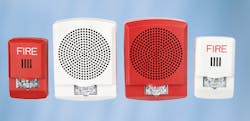Fire & Life Safety: Audibility for All?
A reader who was upgrading a fire alarm system in an old country church recently emailed in and asked me if he always had to install audible notification appliances so that they provide 15 dB above the normal sound level “throughout” the building. This is a more complicated issue than his question suggests. The rules vary for code-required systems as opposed to optional fire alarm systems installed according to the owner’s wishes.
Required Systems
For required systems, specific rules are provided in the building and fire codes. The level of fire alarm and detection requirements are determined first by what the building is used for.
The first step is finding the list of occupancy types shown in Chapter Three of the ICC Building/Fire Codes and noting its letter designation (plus any number designation) for the project building. For our reader’s example, under Assembly occupancies, you find five Assembly sections numbered 1 through 5. The list under section A-3 is contains “Places of religious worship.” Next, look in Chapter Nine, section 907.2 for the minimum level of protection for the specific occupancy types. Where you see the section for “A – Assembly” then apply these rules to all the “A” occupancy types numbered A-1 through A-5.
Under the letter “A”, read to see if the building’s size, contents or occupant load will also be a factor. Let’s say the occupant load is 300 persons, has no elevator and is un-sprinkled.
Chapter 9, section 907.2.1 covers “Group A” requirements: “A manual fire alarm system that
activates the occupant notification system in accordance with Section 907.5 shall be installed in Group A occupancies where the occupant load due to the assembly occupancy is 300 or more.”
Since our reader’s example held 300 persons, then occupant notification would be required in accordance with 907.5. Turning to 907.5, you will find the audibility requirements. Under “Audible alarms” you will find that it does not use the word “throughout” — but is more precise by stating audibility is required “in every occupiable space within the building.” This means that audible notification is not required in the non-occupiable areas of a protected building or structure. It also states “within” — meaning that notification appliances are not required to be installed outdoors, either.
Understanding the Term “Occupiable”
Key to understanding which areas are not required to be able to hear a fire alarm signal is knowing the meaning of the term “occupiable space.” The ICC codes define it as “A room or enclosed space designed for human occupancy in which individuals congregate for amusement, educational or similar purposes or in which occupants are engaged at labor, and which is equipped with means of egress and light and ventilation facilities meeting the requirements of this code.” Thus, attics, crawl spaces, open parking garages, closets and similar rooms or spaces are not required to be included in your notification appliance layout. Just because someone is able to climb or squeeze into a room or space does not mean it is occupiable, and must be provided with audible or visible notification.
Recently, NFPA added the following two terms to NFPA 72:
- Occupiable — a room or enclosed space designed for human occupancy.
- Occupiable Area — an area of a facility occupied by people on a regular basis.
The Annex explains that “occupiable” is used “to determine areas that require certain features of a system. It is important for designers to understand that unless otherwise required, spaces that are not occupiable might not require or need coverage by initiating devices or occupant notification appliances. For example, most closets would not be considered to be occupiable; however, a space of the same size used as a file room would be considered occupiable.”
Designers and most technicians know that the terms in NFPA 72 are only applied by the local authority having jurisdiction if they are not first provided by their adopted building and fire codes. I sometimes use the NFPA definitions to help me understand NFPA standards they appear in — but I will always refer to the building/fire code definition as the official meaning, since this is the only version officially used by the inspectors and fire code officials.
The reader’s problem stemmed from someone asking why the notification appliances could barely be heard, and the reader’s lack of confidence caused him to forget that the room they were in was not actually (and legally) considered an “occupiable area.”
Non-Required Systems
Suppose the church holds only 299 persons — then the installation of any fire alarm system would be considered “non-required.” The building/fire codes state that equipment would still have to be installed properly, but the level of protection would be up to the owner. For example, several automatic detectors could be installed in key locations, a keypad installed in the church’s office area with a horn in the basement’s custodial area. Stating the system complies with the owner’s performance requirements and operates in the “private mode” should allow the plans to sail through the permit/approval process since this limited system actually exceeds the minimum code requirements for audibility (none) even though it uses just one horn and a beeping keypad.
Once again, we see that knowing how the building/fire codes relate to standards such as NFPA 72, is key to providing the necessary protection for a building’s occupants and yet allow for proper voluntary systems to also pass the permit and inspection process.
Greg Kessinger is SD&I’s fire alarm and codes expert and a regular contributor. Please email him your fire & life safety questions at [email protected].
About the Author

